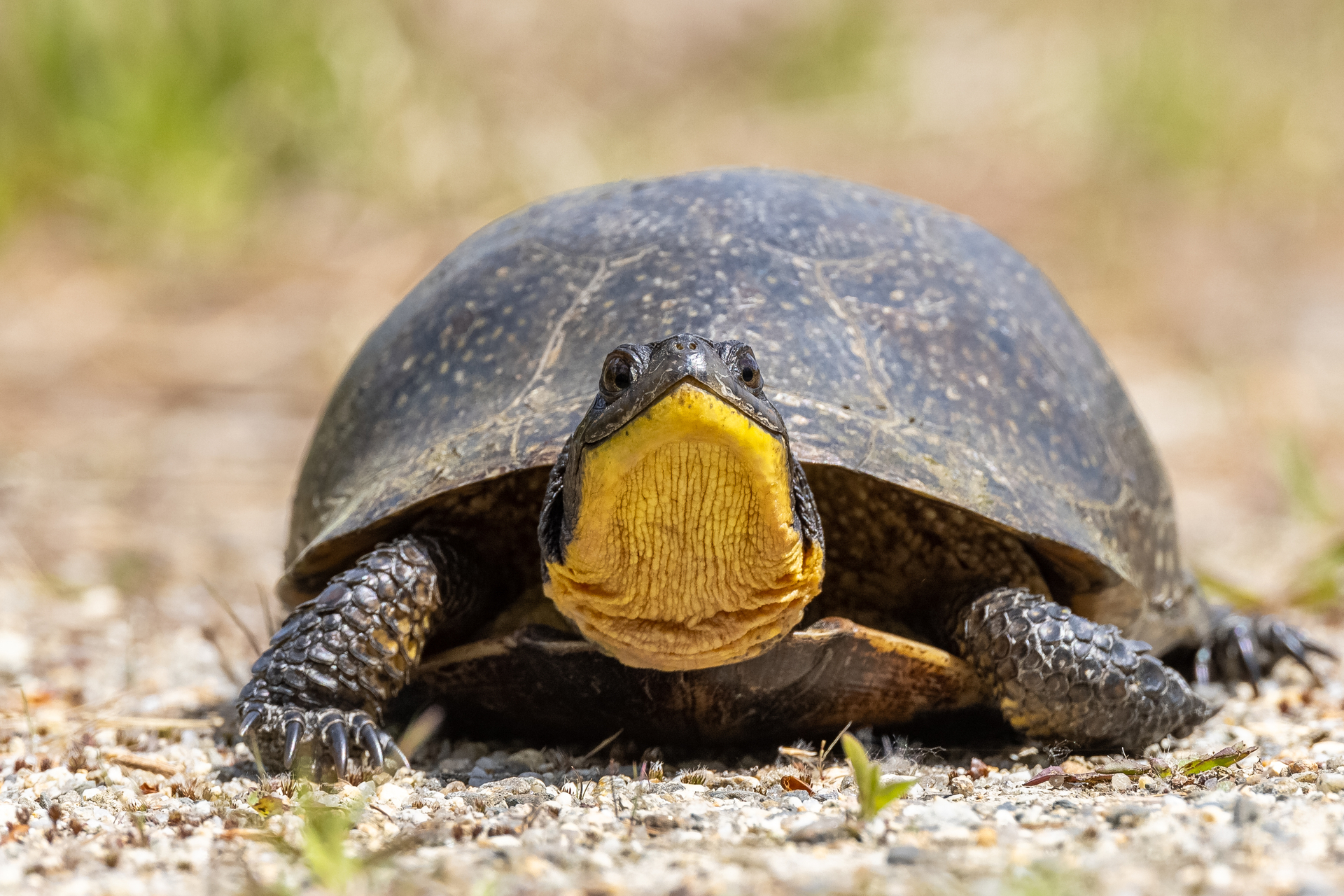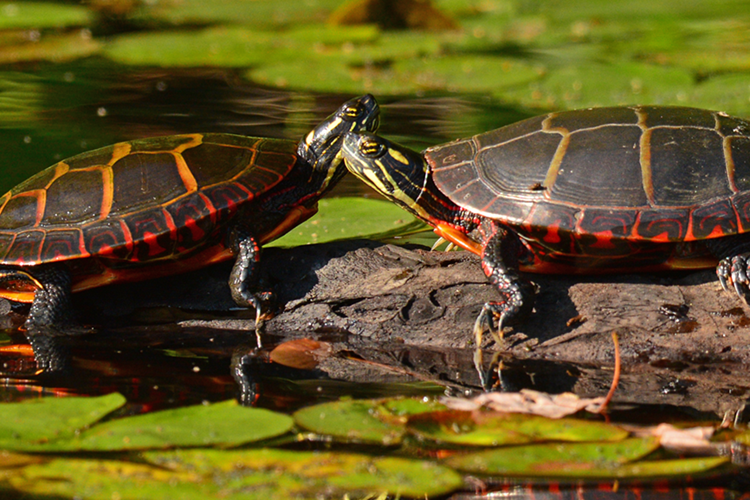Come Out of Your Shell
July 01, 2022
Turtle Here, Turtle There, Turtle Everywhere
As you enjoy a nice summer walk along a pond or kayak on a lake, you’re more than likely to see Painted Turtles resting on a log or rock. It’s easy to recognize these turtles with the bright yellow bands streaking their heads and olive shells.
Seeing spots? Then you’ve stumbled upon a Spotted Turtle. These turtles, which are only 3.5 to 5 inches long and feature unmistakable yellow polka dots covering their black shells, can be found in a variety of wetland habitats, including marshes, bogs, ditches, ponds, and brooks. When looking for these dazzling turtles try not to disturb them, as they will dive to hide in the mud and debris.
Be careful not to accidentally startle an Eastern Musk Turtle, or you might smell it before you see it. Musk turtles are difficult to find because they are primarily nocturnal and often overlooked. They are known for the unpleasant odor produced when threatened, earning them the nickname “stinkpot.”
It’s hard to miss the epic Common Snapping Turtle. These turtles fit the prehistoric look with their ridged shells and spiky tails and can grow up to 19 inches long. Snapping turtles have powerful jaws and are surprisingly quick, so it’s always best to give them plenty of space.
Species on the Decline
While the Painted and Snapping turtle are common sights in Massachusetts, not every species is as widespread, and some are even disappearing at an alarming rate. This is due to a combination of habitat loss from human development and climate change, as well as pollution and predation. Turtles are especially vulnerable to becoming roadkill, as they often cross roads to go from their wetland habitats to nesting sites.
Six of the 10 native species that breed in the state are listed as threatened or endangered under the Massachusetts Endangered Species Act. These are the Bog Turtle, Northern Red-bellied Cooter, Eastern Box Turtle, Wood Turtle, Blanding’s Turtle, and the Diamondback Terrapin. The terrapin is the only turtle in North America that makes its home in brackish water, where saltwater from the ocean mixes with freshwater.
For these species to survive, and even rebound, they must remain undisturbed. If you happen to see one, from a distance snap a photo and then report it to MassWildlife’s Natural Heritage & Endangered Species Program. Many rare turtle populations are threatened by illegal collection, so it’s best not to share their locations with others or on social media.
Friend or Foe?
Each summer, our sea turtle friends such as the Kemp’s Ridley, Green, Loggerhead, Leatherback, and Atlantic Hawksbill all travel from the tropical southern water to feed along Massachusetts beaches. All five species are threatened or endangered, and hundreds each year fail to make it out of Massachusetts Bay in time to swim south before water temperatures drop to the point where they can no longer swim.
More inland, the non-native and invasive Red-eared Slider is commonly found in ponds, lakes, and slow-moving streams. These turtles are more foe than friend, as they compete with native species for resources and are becoming more prevalent due to pet trading and illegal release into the wild.
Turtle Time
Seeing a Spotted Turtle or an Eastern Musk Turtle may be difficult, but take a walk through almost any wildlife sanctuary and you’ll discover an abundance of Snapping and Painted turtles. Visit some of the sanctuaries below and keep count of how many turtles you see.
Broadmoor, Natick
Walk along the All Persons Trail or Mill Pond/Marsh Trail at Broadmoor to watch Painted Turtles basking in the summer sun atop logs and rocks in the water. In addition to turtles, you may even see a mink or muskrat at the water’s edge.
North Hill Marsh, Duxbury
Take the Loop Trail at North Hill Marsh to circle the pond, pass by cranberry bogs, and travel through Duxbury Town Forest. Within the 90-acre pond, you might see a large Snapping Turtle surfacing for air.
Wachusett Meadow, Princeton
Explore Otter Pond off of Brown Hill Loop at Wachusett Meadow to observe Painted Turtles, river otters, and minks. Throughout the summer, you can also rent a canoe to paddle on Wachusett Meadow’s Wildlife Pond, where you might catch a closer glimpse of an idling turtle.
Stony Brook, Norfolk
Follow the Sensory Trail at Stony Brook to smell the pine forest, hear the wildlife living in the marsh, and see a giant Snapping Turtle in Kingfisher Pond. Cross onto the Pond Loop Trail and keep count of how many Painted Turtles you come across.
Canoe Meadows, Pittsfield
Just one mile from the heart of Pittsfield, you can follow the Sacred Way Trail at Canoe Meadows to pass by scenic views of the Housatonic River, Sackett Brook, and West Pond, and see Painted and Snapping turtles along the way, too.
Wellfleet Bay, South Wellfleet
Volunteer with Wellfleet Bay to protect and monitor Diamondback Terrapins or take the Silver Spring Trail to walk along a small freshwater pond and catch another glimpse of a Painted or Snapping turtle.
Didn’t see your favorite sanctuary? Visit massaudubon.org/sanctuaries to find more places to explore.






